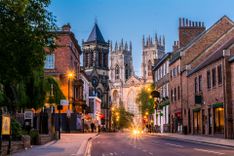13. Enjoy a variety of restaurants
Cambridge has a lot to offer foodies. For the area's best restaurants, you should book a table (well in advance) at Midsummer House, a two Michelin-starred British-French restaurant. Not only is the food excellent, the staff couldn’t be more warm and personable – a welcome change from the efficient but distant service in many other expensive restaurants.
For something a bit more affordable, head to Trockel, Ulmann & Freunde, also known to students as the ‘German café’ or ‘German soup kitchen’, who offer delicious, well-priced soups and snacks right in the city centre.
If you’d like to venture a little further afield, the Mill Road area has a number of Middle Eastern and Asian restaurants, perhaps best among them Bibimbap House, and even further afield is the gorgeous village of Grantchester where The Orchard does an excellent cream tea.
If you choose to head to Cambridge's rival city, read our guide to the best bars in Oxford to get a better feel for the city's charisma.




















